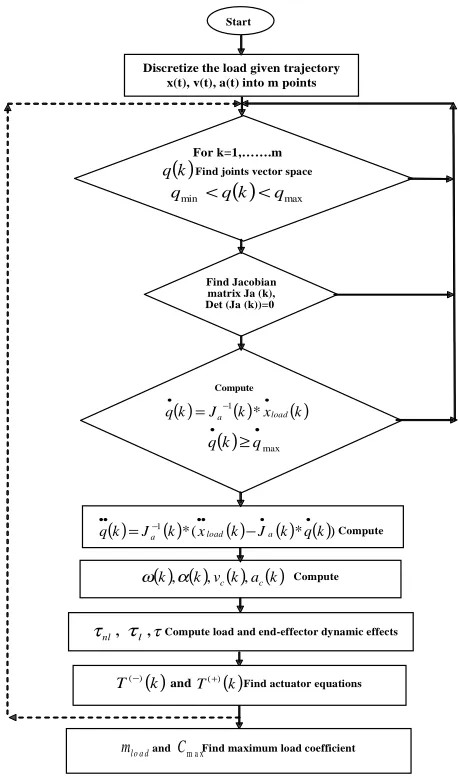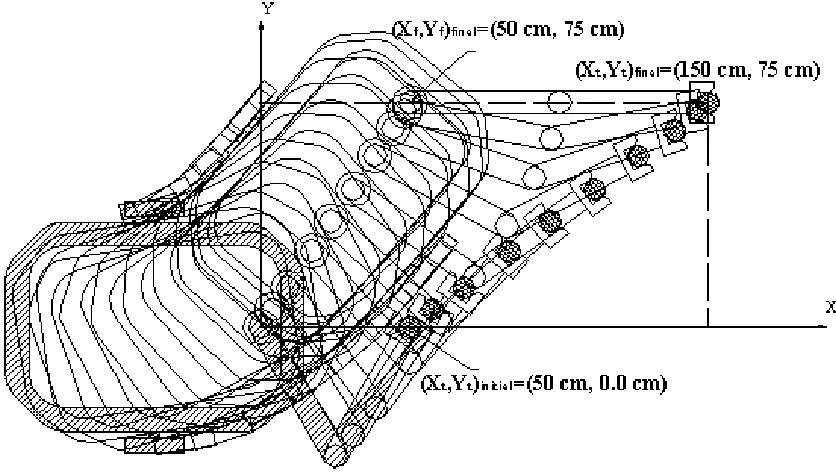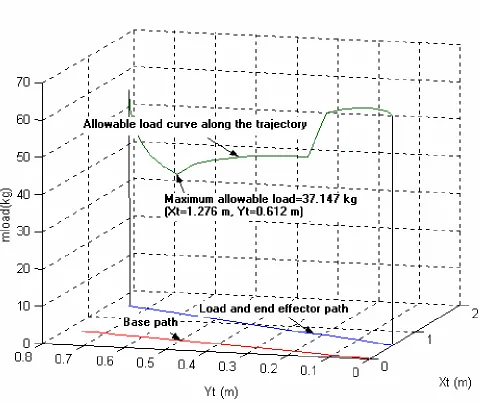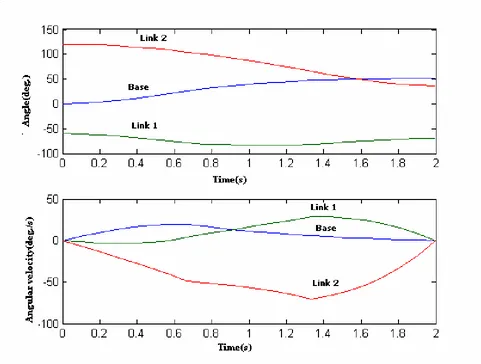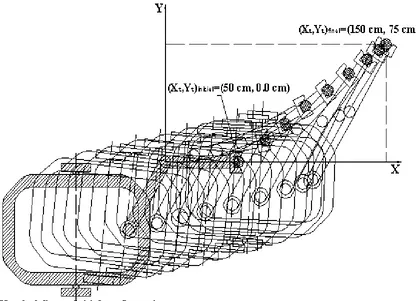RESEARCH NOTE
MAXIMUM ALLOWABLE LOAD ON WHEELED MOBILE
MANIPULATORS
M. Habibnejad Korayem and H. Ghariblu
Department of Mechanical Engineering, Iran University of Science and Technology Tehran, Iran, hkorayem@iust.ac.ir
(Received: February 9, 2002 – Accepted in Revised Form: May 15, 2003)
Abstract This paper develops a computational technique for finding the maximum allowable load
of mobile manipulators for a given trajectory. The maximum allowable loads which can be achieved by a mobile manipulator during a given trajectory are limited by the number of factors; probably the dynamic properties of mobile base and mounted manipulator, their actuator limitations and additional constraints applied to resolving the redundancy are the most important factors. To resolve extra D.O.F introduced by the base mobility, additional constraint functions are proposed directly in the task space of mobile manipulator. Finally, in two numerical examples involving a two-link planar manipulator mounted on a differentially driven mobile base, application of the method to determining maximum allowable load is verified. The simulation results demonstrates the maximum allowable load on a desired trajectory has not a unique value and directly depends on the additional constraint functions which applies to resolve the motion redundancy.
Key Words Given Trajectory, Load Carrying Capacity, Base Replacement, Manipulator
ﻩﺪﻴﮑﭼ
ﻩﺪﻴﮑﭼ
ﻩﺪﻴﮑﭼ
ﻩﺪﻴﮑﭼ
ﺮﻴﺴﻣﻚﻳﺭﺩﺭﺍﺩﺥﺮﭼﻲﺗﺎﺑﺭ ﻱﺎﻫﻭﺯﺎﺑﺭﺎﺑﻞﻤﺣﺖﻴﻓﺮﻇﺮﺜﻛﺍﺪﺣﻦﻴﻴﻌﺗﻲﺗﺎﺒﺳﺎﺤﻣﺵﻭﺭﻪﻟﺎﻘﻣﻦﻳﺍﺭﺩ
ﺪﻳﺁﻲﻣ ﺖﺳﺪﺑﺺﺨﺸﻣ
. ﺮﻴﺴﻣ ﻲﺣﺍﺮﻃﺭﺩ ﻢﻬﻣ ﻱﺎﻫﺭﺎﻴﻌﻣﺯﺍ ﻲﻜﻳﻞﻤﺣ ﻞﺑﺎﻗﺭﺎﺑ ﺮﺜﻛﺍﺪﺣﺎﺑ ﻭﺯﺎﺑﻚﻳ ﺖﻛﺮﺣ
ﻲﻣﺖﻛﺮﺣ
ﺪﺷﺎﺑ .
ﺍﺭﻙﺮﺤﺘﻣﻲﺗﺎﺑﺭﻱﻭﺯﺎﺑﻚﻳﺭﺎﺑﻞﻤﺣﺖﻴﻓﺮﻇﺪﻨﻧﺍﻮﺗﻲﻣﻱﺩﺪﻌﺘﻣﻞﻣﺍﻮﻋ ﺪﻨﻫﺩﺭﺍﺮﻗﺮﻴﺛﺄﺗﺖﺤﺗ
.
ﻪﻠﺌﺴﻣ ﻞﺣ ﻱﺍﺮﺑ ﻪﻛ ﻲﻓﺎﺿﺍ ﻱﺎﻫﺪﻴﻗ ﻭ ﻙﺮﺤﺘﻣ ﻱﺎﻫﺭﻮﺗﻮﻣ ﺭﻭﺎﺘﺸﮔ ﺖﻳﺩﻭﺪﺤﻣ ،ﻭﺯﺎﺑ ﻭ ﻪﻳﺎﭘ ﻲﻜﻴﻣﺎﻨﻳﺩ ﺹﺍﻮﺧ
ﺪﻧﺩﺮﮔﻲﻣ ﻝﺎﻤﻋﺍ ﺩﺍﺯﺎﻣ ﻱﺩﺍﺯﺁ ﺕﺎﺟﺭﺩ
, ﻲﻣ ﻲﻘﻠﺗﻢﺘﺴﻴﺳ ﺭﺎﺑ ﻞﻤﺣ ﺖﻴﻓﺮﻇ ﺭﺩ ﺭﺍﺬﮔ ﺮﻴﺛﺄﺗ ﻞﻣﺍﻮﻋ ﻦﻳﺮﺘﻤﻬﻣ ﺯﺍ
ﺪﻧﺩﺮﮔ .
ﻛﺮﺣ ﻪﻄﺳﺍﻮﺑﻪﻛﻲﻓﺎﺿﺍ ﺩﺍﺯﺎﻣ ﺕﺎﺟﺭﺩﻪﻠﺌﺴﻣﻞﺣﻱﺍﺮﺑ
ﻪﺑﻲﻳﺎﻫﺪﻴﻗ،ﺪﻧﺩﺮﮔ ﻲﻣﻞﻴﻠﺤﺗﻢﺘﺴﻴﺳ ﻪﺑﻪﻳﺎﭘ ﺖ
ﺪﻧﺍﻩﺪﺷﻩﺩﻭﺰﻓﺍﻢﺘﺴﻴﺳﺖﻛﺮﺣﻪﻟﺩﺎﻌﻣﻪﺑﻊﺑﺍﻮﺗﺕﺭﻮﺻ .
ﻱﺩﺪﻋﻝﺎﺜﻣﻪﻧﻮﻤﻧﻭﺩﺭﺩ ,
ﻱﺍﻪﺤﻔﺻﻲﻜﻨﻴﻟﻭﺩﻱﻭﺯﺎﺑﻚﻳ
ﻩﺩﺎﻔﺘﺳﺍﺭﺎﺑﻞﻤﺣﺖﻴﻓﺮﻇﻦﻴﻴﻌﺗﺵﻭﺭﺩﺮﺑﺭﺎﻛﺶﻳﺎﻤﻧﻱﺍﺮﺑ،ﺖﺳﺍﻩﺪﺷﺐﺼﻧﺭﺍﺩﺥﺮﭼﻙﺮﺤﺘﻣﻪﻳﺎﭘﻚﻳﻱﻭﺭﻪﻛ
ﺗﺩﺭﻮﻣﻢﺘﻳﺭﻮﮕﻟﺍﺖﺤﺻﻭﻩﺪﺷ
ﺖﺳﺍﻪﺘﻓﺮﮔﺭﺍﺮﻗﻖﻴﻘﺤ .
ﺭﺎﺑﺮﺜﻛﺍﺪﺣﻪﻛﺪﻫﺩﻲﻣﻥﺎﺸﻧﺡﻮﺿﻮﺑﻱﺯﺎﺳﻪﻴﺒﺷﺞﻳﺎﺘﻧ
ﻲﻣﻝﺎﻤﻋﺍﺩﺍﺯﺁﻪﺟﺭﺩﻪﻠﺌﺴﻣ ﻞﺣﻱﺍﺮﺑﻪﻛﺖﺳﺍ ﻲﻳﺎﻫﺪﻴﻗﻉﻮﻧﺯﺍﻲﻌﺑﺎﺗ ﺺﺨﺸﻣﺮﻴﺴﻣﻚﻳ ﺭﺩﻞﻤﺣﻞﺑﺎﻗﺯﺎﺠﻣ ﺩﺭﺍﺪﻧﻲﻳﺎﺘﻜﻳﺭﺍﺪﻘﻣﻭﺩﺩﺮﮔ .
1. INTRODUCTION
The maximum allowable load of a fixed base manipulator is often defined as the maximum payload that the manipulator can repeatedly lift in its fully extended configuration. However, to determine the maximum allowable load of a robot must take into account the inertia effect of the load along a desired trajectory as well as the manipulator dynamics. Wang and Ravani were shown the maximum allowable load of a fixed base manipulator on a given trajectory is primarily
Papadopoulos and Gonthier considered the effect of base mobility of robotic manipulators on large force quasi-static tasks [6]. They introduced the force workspace concept for identifying proper base guaranteeing task execution along desired paths. In their work the dynamic effects of the load and manipulator are not examined. There are some other works, which published about carrying heavy loads and stability of the wheeled mobile manipulators [7-9]. Also there are some other research studies which consider the problem of large force task planning and carrying heavy loads on mobile manipulators, however non of them consider the problem of finding maximum load carrying capacity of mobile manipulators.
In this paper, we present a new method of determining the maximum allowable load for mobile manipulators subject to both actuator and redundancy constraints. For motion planning and redundancy resolution, additional constraint functions and the augmented Jacobian matrix are used. The recursive Newton-Euler method is used to formulate the dynamic effects of combined mobile base and manipulator motion on joint actuator torques. A general computational procedure is presented for finding the maximum allowable load of multi-link mobile manipulators for a desired trajectory. Finally, by numerical examples involving a two-link planar manipulator mounted on a differentially driven mobile base, application of the method is presented and simulation test is carried out.
2. KINEMATIC MODELING OF MOBILE MANIPULATORS
The position of the end effector in the task space of mobile manipulators can be defined as bellow:
)
(
)
(
b m/b mb
q
X
q
X
X
=
+
(1)where
X
=
[
x
y
z
]
T andX
b=
[
x
by
bz
b]
Tare the position of the end effector and the base in
the inertial reference frame.
X
m/b=
[
x
m/by
m/bz
m/b]
T is theposition vector of manipulator with respect to the
base. The Jacobian equation of the mobile manipulator can be determined as:
• •
=
J
q
X
(2)where
J
=
(
J
bJ
m)
and q (qb qm)T • • •= .
m
R
X
∈
•
denotes the task velocity space of mobile manipulator with respect to the fixed coordinate frame and
q
•∈
R
n is the joints velocity space.The general form of the constraint equations can be written as:
0
=
•q
J
c (3)where
J
cR
c n ×∈
. On the other hand, the combined system of mobile manipulator has extra degrees of freedom on its motion. Therefore to resolving the redundancy, we can applyr
additional constraint equations, which can be written as:• •
=
J
q
X
Z z (4)where
J
z∈
R
r×n. Hence the kinematic equation of mobile manipulators by combining the Equations (2), (3) and (4) is written as:(
)
•• •
=
X X J J J T q
c z T
z 0 (5)
Here
J
a=
(
J
J
zJ
c)
T is named as augmented Jacobian matrix. TheJ
zmatrix can be obtained using singular value decomposition and other methods. However, the simple method is to choose user specified constraint equations in general form [10]:X
z=
g q
( )
(6)By differentiating of Equation 6 with respect to time, we have
• •
=
J
q
The augmented Jacobian matrix
J
a, regardless of the configurationq
of the mobile manipulator must be non-singular, or the determinant ofa
J
must be non-zero:.
0
)
(
J
a≠
Det
(7)If the resultant
J
a to be non-singular then joints velocity acceleration vectors are found:T z a X X
J
q
= − • •
•
0
1
(8)
) 0
(
1 •• •• • •
− • •
−
=J X X J q
q a
T z
a (9)
3. DYNAMIC MODELING OF MOBILE MANIPULATORS
In order to obtain DLCC for a mobile
manipulator, proper modeling of mobile
manipulator and load dynamic is a
prerequisite. Therefore the desired values are
evaluated on the
(n+1)thcoordinate system
attached to the center of mass of the
end-effector and load as a composite body [1]. The
proposed algorithm is based upon the forward
recursive Newton-Euler formulation that is
used to determine the linear and angular
accelerations of the
ithlink (
ω
iand
α
i) and its
mass center (
v
ciand
a
ci) iteratively computed
from link 1 out to link
n. The dynamic
equations are obtained using the Newton-Euler
approach as follows:
ci i
ma
F
=
(10)
i ci i i ci
i
I
I
N
=
α
+
ω
×
ω
(11)
where
c
iis the coordinate frame has its origin
at the center of the link and has the same
orientation as the
ithlink coordinate frame.
Then, the joint actuator torque's is computed
recursively from link
nback to link 1 by the
backward Newton-Euler formulation as:
i i i i i i i i
F
f
R
f
=
+1 +1 +1+
(12)
1 1 1 1 1
1
1 +
+ + + +
+
+
+
×
+
×
+
=
ii i i i i i i ci i i i i i i i i i
f
R
P
F
P
n
R
N
n
(13)
i i T i i i
=
n
z
τ
(14)
Here
i+1iR
describes the rotation matrix from
coordinate frame
i+1relative to coordinate
frame
i
. The other variables denoted by the
general form
if
idescribe the vector
f
in the
ith
link described in coordinate frame i
. Also
on the above formulation,
f
denotes joint
force,
n
joint torque,
P
position vector,
τ
joint’s actuator torque and
z
is the unit
vector in the direction of joint’s rotation axis.
4. DETERMINING MAXIMUM ALLOWABLE LOAD
For determining the maximum allowable load,
separate computation of the actuators torque
for compensating the load dynamics
τ
land
the manipulator dynamics
τ
nlon the each joint
is needed. Therefore the mobile manipulator
dynamic computations are executed in two
steps. In both steps, by neglecting the load
moment of inertia
I
loadand considering only
mass portion of load,
n+1n
n+1is set equal to
zero in the dynamic equations. In the first step
the total dynamic effects of the load and
mobile manipulator on the actuators
τ
is
considered and
n+1f
n+1is set equal to
)
(
cc
g
a
end-effector and load masses and accelerations as a
composite body and
g
is the gravitational
acceleration vector. In the second step,
11 + + n n
f
is set equal to zero, which considers only the
effect of the mobile manipulator dynamics on
the joint actuators
τ
nl. By subtracting
τ
nlfrom
τ
, the
τ
lis resulted:
l
τ
=
τ
-
τ
nl(15)
In this Section the computational procedure
for determining the maximum allowable load
is outlined and also flowcharted in Figure 1.
Continuous trajectory of the end effector is
discretized into equally spaced
m
points along
the trajectory, and then the total torque
on
jth
joint at each grid point
τ
j(
k
)
is obtained
where
k
=
1
,
2
,...,
m
. The joints actuator torque
constraints are formulated based on the typical
joint-speed characteristics of DC motors as
follows:
• − • +−
−
=
−
=
q
k
k
T
q
k
k
T
2 1 ) ( 2 1 ) ((16)
where
k
1=
T
sand
k
2=
T
s/
ω
nl,
T
sis the stall
torque and
ω
nlis the maximum no-load speed
of the motor. If
τ
nl(
k
)
satisfies the following
inequality:
) ( ) ( ) ( ( ) ) ( k T k kTj + ≤
τ
nl ≤ j −(17)
and if
) ( ) ( ) ( ) ( ( ) ) ( k k T k kTj −τnl < j −τnl
−
+
(18)
then the load coefficient at
jthjoint
C
jcan be
calculated as bellow:
)
(
/
)
(
)
(
)
(
k
T
( )k
k
k
C
j=
j +−
τ
nlτ
l(19)
else, if Equation 18, is not satisfied then:
) ( / ) ( ) ( )
(k T( ) k k k
Cj = − −
τ
nlτ
l(20)
otherwise, if
nl(k) T( )(k)+
>
τ
and
0
)
(
k
<
lτ
then:
)
(
/
)
(
)
(
)
(
k
k
T
( )k
k
C
j=
τ
nl−
+τ
l(21)
Start
Discretize the load given trajectory x(t), v(t), a(t) into m points
For k=1,…….m
Find joints vector space
( )k q
( ) max min qk q
q < <
Find Jacobian matrix Ja (k), Det (Ja (k))=0
Compute ( )k J ( )k x ( )k
q a load
• − •
= 1 *
( ) max
• • ≥q k q Compute
( ) 1( )*( ( ) ( ) ( )* )
k q k J k x k J k
q a load a
• • • • − • • − = Compute
( ) ( ) ( ) ( )k,αk,vck,ack
ω
Compute load and end-effector dynamic effects
τ , l τ , nl τ
Find actuator equations
( )k T(+)
and
( )k T(−)
Find maximum load coefficient m a x
C
and
l o a d
m
Under the different conditions, unrealizable
case encountered (e.g., if the desired speed is
too high or the desired trajectory is physically
impossible) and we have:
0
)
(
k
=
C
j(22)
The maximum load coefficient at the
jthjoint along the given trajectory is computed as:
}
{
C k k mCj,max =min j( ), =1,2,...,
(23)
Finally, the maximum load coefficient for
the mobile manipulator
C
maxalong the given
trajectory is computed from
{
C
j
to
n
}
C
max=
min
j,max,
=
1
. (24)
where
n
is the number of manipulator’s joint.
The maximum allowable load carrying
capacity for the mobile manipulator is
computed from the following equation:
l load
C
m
m
=
max×
(25)
5. SIMULATION STUDIES
To investigate the proposed algorithm, some
simulation studies are presented. In these
studies, a specified trajectory for the load is
assumed. A two-link planar manipulator
mounted on a differentially driven mobile base
is considered as a case study (Figure 2). The
joint actuators are similar and their constants
are
ω
nl =3.5rad /sand
k
1=
63
.
22
N
.
m
. For
simulation study two cases are considered in a
situation where the same trajectory for the load
is selected, but a different additional constraint
functions are applied to resolve the motion
redundancy in each case.
5.1. Simulation Model-1
The planar two-link arm is mounted on mobile base at point
F
on the main axis of the base (Figure 2). The position of pointF
relative to world coordinate frame is denoted byx
f,
y
f . In this case, the user specified additional constraintsX
z=
g q
( )
, are considered as the base position coordinatesF
(
x
f,
y
f)
.We combine the additional constraint Equations (A-3), the end effector velocity components Equations (A-4) and the nonholonomic constraint Equation (A-5) (please see Appendix A for details).
Then we rewrite these equations in the matrix
form as mentioned in the Equation (5):
=
−
• •
• •
• • • • •
f f e e f f
y x y x y
x J J J
J J J
l Cos
Sin 0
0 0 0 1
0
0 0 0 0
1
1 0
0 1
0 0 )
( )
(
2 1 0 35 34 33
25 24 23 0 0 0
θ θ θ θ
θ
(26) where, the expression of J23,J24,J25,J33,J34 and
35
J are given by:
) sin(
)
sin( 0 1 2 0 1 2
1 24
23 =J =−l θ +θ −l θ +θ +θ
J ,
) sin( 0 1 2 2
25 = −l θ +θ +θ
J ,
) cos(
)
cos( 0 1 2 0 1 2
1 34
33 = J =l θ +θ +l θ +θ +θ J
and J35 =l2cos(θ0 +θ1+θ2)
By direct calculation, the determinant of the
augmented Jacobian matrix on the left hand side of the Equation (26) is found
) sin( )
(J l0 l1 l2 θ2
Det a = × ×
Hence
J
ais non-singular provided thato o 180
0
2 ≠ or
θ . That is the two arms are not along the same axis. Suppose that the base length is
l
0=
40
cm
, the links length arecm
l
l
1=
2=
50
. Let the initial configuration ofthe mobile base is given by:
}
0
,
0
,
0
{
}
,
,
{
x
y
0cm
cm
rad
q
i=
f fθ
=
The initial task vector is considered as
cm
y
x
y
x
X
i=
{
t,
t,
f,
f}
i=
{
50
,
0
,
0
,
0
}
and desired final task vector at time t=2Secis specifiedas
X
f=
{
x
t,
y
t,
x
f,
y
f}
f=
{
150
,
75
,
50
,
75
}
cm
. Notice that final tool tip position is not feasiblewithout the base motion. The desired task space path is specified as straight lines from initial to final configuration. By simulation study the overall movement of the mobile manipulator is found and shown in Figure 3.
Using the recursive Newton–Euler’s dynamic formulation the torques at the joints of the manipulator are obtained as follows:
2 1 16 1 15 2 2 14 2 13
12 11
1
ω
ω
ω
ω
τ
H
H
H
H
Y
H
X
H
f f+
+
+
+
+
=
• •
• • •
•
(27)
2 1 25 1 24 2 23 22
21
2 ω ω ω
τ =H Xf+H Yf +H +H +H
• •
• • •
•
(28) where,
[
]
[
(( ) )sin( )]
) sin(
) (
1 0 1 1 1 2
2 1 0 2 2 2 11
θ θ
θ θ θ
+ +
+
+ + + +
− =
c l
l c
l m l m m
l m l m H
) cos( ) )
((
) cos(
) (
1 0 1 1 1 2
2 1 0 2 2 2 12
θ θ
θ θ θ
+ +
+
+ + + +
=
c l
l c
l m l m m
l m l m H
) cos( )
( 2 2 2 2
1 2 2 2
2 2 2
13 I m l ml l m l ml θ
H =c + c + l − c + l
) sin( )
( 2 2 2 2
1
14 l m l ml θ
H =− c + l
) cos( ) (
)
( 2 12 2 2 2 2
2 1 1 1
15 I ml m m l m l ml θ
H =c + c + + l + c + l
) sin( )
( 2 2 2 2
1
16 l m l ml θ
H =− c + l
) sin(
)
( 2 2 2 0 1 2
21=− ml +ml θ +θ +θ
H c l
) cos(
)
( 2 2 2 0 1 2
22 = m l +ml θ +θ +θ
H c l
2 2 2
2 2 2
23 I m l ml
H =c + c + l
)
cos(
)
(
2 2 2 1 224
m
l
m
l
l
θ
H
=
c+
l)
sin(
)
(
2 2 2 1 225
m
l
m
l
l
θ
H
=
−
c+
lIn the above formulations 1 0 1
• •
+
=
θ
θ
ω
and2 1 0 2
• • •
+
+
=
θ
θ
θ
ω
are the angular velocities of the manipulator links relative to inertial coordinate frame andl
ci is length of theith
link center of mass from its distal joint. The task space trajectory is discretized into equally spacedm
=
40
points. Then by the procedure outlined in the Sec. 4 the maximum allowable load of the mobile manipulator is determined (Figure 4). The allowable load carrying capacity for the mobile manipulator at each point of trajectory is determined and maximum allowable load wasfound
m
load=
37
.
147
kg
at the pointm
x
t=
1
.
276
andy
t=
0
.
612
m
. Also, the corresponding base and links angles and angular velocity variations along the trajectory are illustrated in Figure 5.5.2. Simulation Model-2
The planar mobile manipulator similar to the Case 1 is considered. The manipulator elbow angle
β
between two arms and end effector orientation relative to the world coordinate frameα
are used as additional constraint equations. Thus2 1 0 2 2 1
θ
θ
θ
α
θ
π
β
+
+
=
=
−
=
=
z zX
X
(29)
The corresponding differential kinematic equation and augmented Jacobian matrix is derived by combining the Equations (A-4), (A-5) and time derivatives of the Equation 29
=
−
−
• • • • • • • • •β
α
θ
θ
θ
θ
θ
e e f fy
x
y
x
J
J
J
J
J
J
l
Cos
Sin
0
1
0
0
0
0
1
1
1
0
0
1
0
0
1
0
0
)
(
)
(
2 1 0 35 34 33 25 24 23 0 0 0(30)
The determinant of the augmented Jacobian matrix on the left hand side of the Equation (30) is found to be
Det
(
J
)
=
l
0≠
0
. Therefore, the matrixJis non-singular regardless of the configuration of the mobile manipulator.The initial task vector is considered
as
X
i=
{
x
t,
y
t,
α
,
β
}
i=
{
50
cm
,
0
cm
,
0
o,
120
o}
anddesired final task vector at time t =2Secis
specified as
}
180
,
60
,
75
,
150
{
}
,
,
,
{
x
y
cm
cm
o oX
f=
t tα
β
f=
Similar to the Case 1 the final tool tip position is not attainable without the base motion. By considering straight lines from initial to final configuration for the task space variables, the overall movement of the mobile manipulator is determined and illustrated by the simulation study (Figure 6).
The task space trajectory is discretized into equally spaced m=40points. The allowable load carrying capacity for the mobile manipulator at every point of the trajectory is determined and maximum allowable load is found
kg
mload =20.188 at point
)
0
.
0
,
5
.
0
(
x
t=
m
y
t=
m
as shown in Figure 7. The corresponding base and links angle and angular velocity variations along the trajectory are illustrated in Figure 8.In the above two case studies, the same trajectory for the load is considered. However, in each case different additional kinematical constraint is considered for redundancy resolution. It is seen that load capacity of the mobile manipulator varies along its path depends on the predefined trajectory of the load. Also it can be seen, the maximum allowable load has a different value in each case. Therefore, the value of maximum allowable load for a given trajectory depends on the additional constraint functions that we apply to redundancy resolution. The type of these constraint functions directly depends on the user requirements and can be chosen arbitrarily by considering workspace limitations, obstacle avoidance or optimization criteria.
many functions and libraries for the kinematic and dynamic analysis of robotic manipulators [11,12].
6. CONLUSIONS
The motion planning and dynamic modeling of
mobile manipulators using the augmented Jacobian technique and recursive Newton-Euler method are presented. The application of the algorithm is outlined by simulation studies in detail. In the two case studies a two-link planar differentially driven mobile manipulator with a similar trajectory for the load, and different additional constraint functions for redundancy resolution is considered. In the first
case the base coordinates
x
f andy
f are appliedas additional constraints and corresponding maximum allowable load is computed
147
.
37
=
loadm
kg. In the second case, the angle between the two links of manipulator and angle of the end effector are considered as additional constraints and corresponding maximum allowable load is computed as mload =20.188 kg. Hence, the results of the case studies are shown that the allowable load is variable along the given trajectory. Also in mobile manipulators in contrast with the fixed base manipulators, the maximum allowable load on a given trajectory has not a unique value. But, a special and unique value may be computed depends on the type of the applied additional constraint functions to resolve the redundancy resolution.APPENDIX A.
A.1. Case 1 Kinematics
The coordinate of the end effector with respect to joint variables
θ
0,
θ
1andθ
2is)
(
sin
)
(
sin
)
(
cos
)
(
cos
x
2 1 0 2 1 0 1 2 1 0 2 1 0 1 eθ
θ
θ
θ
θ
θ
θ
θ
θ
θ
+
+
+
+
+
=
+
+
+
+
+
=
l
l
y
y
l
l
x
f e f (A-1)As explained in Section 5.1 the user specified additional constraints are considered as the base position coordinates f z f z
y
X
x
X
=
=
2 1 (A-2)by differentiating of Equations (A-2) with respect to time we have:
f z f z
y
X
x
X
• • • •=
=
2 1 (A-3)We assume that the speed at which the system moves is low and therefore the two driven wheels
do not sleep sideways. The nonholonomic constraint equation for the manipulator attachment point
F
:0
)
(
cos
)
(
sin
0−
0+
0 0=
• •
•
l
y
x
fθ
fθ
θ
(A-4)where
l
0is the distance between platform center of mass G and pointF(Figure 2). By differentiating Equation (A-1), the end effector velocity components are as below)
cos(
)
(
)
cos(
)
(
)
sin(
)
(
)
sin(
)
(
x
2 1 0 2 1 0 2 1 0 1 0 1 2 1 0 2 1 0 2 1 0 1 0 1 eθ
θ
θ
θ
θ
θ
θ
θ
θ
θ
θ
θ
θ
θ
θ
θ
θ
θ
θ
θ
+
+
+
+
+
+
+
+
=
+
+
+
+
−
+
+
−
=
• • • • • • • • • • • • • •l
l
y
y
l
l
x
f e f (A-5)In the inverse kinematics problem, we find
θ
1andθ
2which correspond to a given load position(xe,ye) and a given platform position(
x
f,
y
f)
.The angle
θ
2is found by the following expression − + − − − = 2 1 2 2 2 1 2 2 2 2 ) ) ( ) ((cos x x y y l l ll
Arc e f e f
θ
(A-6) By discretizing the robot trajectory into
m
points and by numerical integration of Equation (A-4) The angleθ
0can be found. The variablesf
x
•
and
y
f •are known, therefore
0
/
))
(
(
sin
)
(
)
)
(
cos(
)
(
(
)
(
)
1
(
0 0 0 0 0=
×
−
+
=
+
• •l
dt
i
i
x
i
i
y
i
i
f fθ
θ
θ
where
i
=
1
to
m
anddt
=
T
total/
m
. Similarly, the angleθ
1is given by(
)
0
2 2
2 2 2
2 1 1
) (
) (
) )(
sin( ) ))( cos( (
cos
θ
θ θ
θ
−
− + −
− −
− +
=
f e f e
f e f
e
y y x x
y y l
x x l
l Arc
(A-8)
A.2. Case 2 Kinematics
As explained in
Section 5.2 the user specified additional constraints are:
2 1 0 2
2
1z =β =π −θ and X z =α =θ +θ +θ
X
(A-9) In this case, the inverse kinematic of the system is
derived as bellow
β
π
θ
2=
−
(A-10)Similar to the Case 1 the base angle relative to the world coordinate frame
θ
0numerically can be computed by using the Equation (A-7). The angle of the manipulator first link relative to the base main axisθ
1 by using the second part of the Equation (A-9) can be calculated as bellow)
(
0 21
α
θ
θ
θ
=
−
+
(A-11)The base position relative to world coordinate frame at point
F
is calculated by rearranging Equation (A-1). Therefore we have) ( sin )
( sin
) ( cos )
( cos x
2 1 0 1
2 1 0 1 e
α
θ
θ
α
θ
θ
l l
y y
l l
x
e f f
− + −
=
− + −
=
(A-12) 7. REFERENCES
1. Wang, L. T. and Ravani, B., “Dynamic Load Carrying Capacity of Mechanical Manipulators-Part 1: Problem Formulation”, J. of Dyn. Sys. Meas. and Control, Vol. 110, (1988), 46-52.
2. Yao, Y. L., Korayem, M. H. and Basu, A., “Maximum Allowable Load of Flexible Manipulators for a Given Dynamic Trajectory”, Robotics and Computer- Integrated Manufacturing, Vol. 10, No. 4, (1993), 301-309.
3. Korayem, M. H. and Basu, A., “Formulation and Numerical Solution of Elastic Robot Dynamic Motion with Maximum Load Carrying Capacity”, Robotica, Vol. 12, (1994), 253-261.
4. Korayem, M. H. and Basu, A. “Dynamic Load Carrying Capacity for Robotic Manipulators with Joint Elasticity Imposing Accuracy Constraints”, Robotic and Autonomous Systems, Vol. 13, (1994), 219-229. 5. Carriker et al., W. F., “The Use of Simulated Annealing
to Solve the Mobile Manipulator Path Planning Problem”,
Proc. of IEEE Int. Conf. on Rob. and Autom, (1992), 204-209.
6. Papadopoulos, E. G. and Gonthier, Y., “A Frame Force for Large Force Task Planning of Mobile and Redundant Manipulators”, J. of Robotic Systems, Vol. 16, No.3, (1999), 151-162.
7. Papadopoulos, E. G. and Ray, D. R., “A New Measure of Tip Over Stability Margin for Mobile Manipulators”,
Proc. of IEEE Int. Conf. on Rob. and Autom., (1996), 3111-3116.
8. Ghasempoor, A. and Sepehri, N., “A Measure of Stability for Mobile Based Manipulators”, Proc. of IEEE Int. Conf. on Rob. and Autom, (1995), 2249-2254.
9. Ray, D. A. and Papadopoulos, E. G., “Online Automatic Tip-Over Preventation for Mobile and Redundant Manipulators”, J. of Robotic Systems, Vol. 16, No. 3, (1999), 151-162.
10. Ghariblu, H. and Korayem, M. H., “Mathematical Analysis of Kinematic Redundancy and Constraints on Robotic Mobile Manipulators”, Second International Conference of Applied Mathematics, Tehran, (2000), 502-511.
11. C o r ke, P . I . , “R o b o t i c To o l b o x fo r M ATLAB ”,
Manufacturing Science and Technology,Pinjarra Hills, Australia, (2001).
